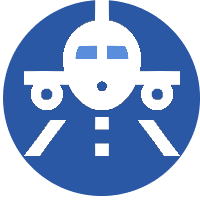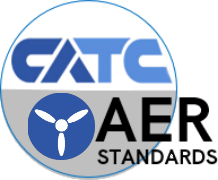BPS CTE Aviation Standards Book
| Site: | Learnbps |
| Class: | CTE-S (AER) Aviation Standards |
| Book: | BPS CTE Aviation Standards Book |
| Printed by: | Guest user |
| Date: | Wednesday, December 17, 2025, 2:15 AM |
Introduction
The CTE-S (AER) Aviation Standards course in Learnbps is
Bismarck Public School District's current progress on prioritizing and deconstructing standards to provide a consistent, clear understanding of what students are expected to learn. The standards are designed to provide guidance so teachers and parents
know what they need to do to help students. Plus help students reflect on the knowledge and skills that they need for success.
Identifier Explanation
AER-HS.5._2.03
The Bismarck Public School District Standards-Based Progress Report displays grades at the concept level. Therefore Bismarck Public School District has modified the North Dakota DPI Identifiers to fit into our student information system PowerSchool for Standards-Based grading. Above is a CTE-Standards AER identifier with smaller muted text showing the addition to the identifier that are the components that BPS adds to the State code.
AER-HS.5_2.03
click on the identifier components for more explanations
AER-HS.5_2.03 Explain the definitions of daylight operation and visual line of sight (VLOS).
Note how the identifiers auto-link to the standards global glossaries.
Global (AER) Standards Glossary 
Course Restore (1.2 MB)
Navigation Tips
TEC Book Navigation
Below is a screenshot of the first page of the BPS CTE Technology and Engineering Standards Book.
Press on the H5P interactive hotspots to learn more about how to navigate the book module in Learnbps. A popup will display the header and the explanation.
Note: Fullscreen option
Standards
 AER-HS.1 Standard 1 - Basics and Control Systems
AER-HS.1 Standard 1 - Basics and Control Systems
Topic 1_1 Aircraft Basics
- AER-HS.1_1.01 Identify the components of different types of aircraft, both exterior and interior.
- AER-HS.1_1.02 Compare and contrast categories and classes of aircraft: airplane, rotorcraft, glider, powered-lift, and lighter-than-air.
- AER-HS.1_1.03 Compare and contrast the various categories into which aircraft are organized during certification: normal, experimental, restricted, acrobatic, utility, and transport.
Topic 1_2 Aircraft Flight Instruments
- AER-HS.1_2.01 Identify the seven basic/standard instruments.
- AER-HS.1_2.02 Describe the operation/limitations of the pitot-static system.
- AER-HS.1_2.03 Describe the operation/limitations of the gyroscopic system.
- AER-HS.1_2.04 Describe the operation/limitations of the magnetic system.
- AER-HS.1_2.05 Describe how instruments will function when the pitot-static system is blocked.
- AER-HS.1_2.06 Explain how the principles of gyroscopic procession and rigidity in space affect the gyroscopic instruments.
- AER-HS.1_2.07 Explain how to cope with magnetic compass errors.
Topic 1_3 Flight Systems
- AER-HS.1_3.01 Explain the function of the battery, alternator, and magneto.
- AER-HS.1_3.02 Discuss fuel systems.
- AER-HS.1_3.03 Explain the cycle of an internal combustion engine.
- AER-HS.1_3.04 Describe common errors with the induction system.
- AER-HS.1_3.05 Compare differences between fixed pitch and constant speed propellers.
- AER-HS.1_3.06 Explain the operation and limitations of the flight control system (primary and secondary).
- AER-HS.1_3.07 Explain the operation and limitations of the powerplant.
- AER-HS.1_3.08 Explain the operation and limitations of the gear system.
- AER-HS.1_3.09 Explain the operation and limitations of the environmental system.
Topic 1_4 Aircraft Construction
- AER-HS.1_4.01 Construct a model aircraft.
- AER-HS.1_4.02 Interpret plans/instructions for homebuilt aircraft.
- AER-HS.1_4.03 Identify techniques used for homebuilt aircraft.
- AER-HS.1_4.04 Assemble/re-assemble a full-scale aircraft part (e.g., fuselage, empennage, wing)
 AER-HS.2 Standard 2 - Science of Flight
AER-HS.2 Standard 2 - Science of Flight
Topic 2_1 Aerodynamics of Flight
- AER-HS.2_1.01 Describe and explain the relationship the four forces of flight.
- AER-HS.2_1.02 Define the angle of attack and critical angle of attack.
- AER-HS.2_1.03 Describe the types of drag, both parasite and induced.
- AER-HS.2_1.04 Explain various wing shapes and how wing tip vortices are created.
- AER-HS.2_1.05 Discuss and compare the four main types of wing flaps and the advantages and disadvantages to their uses.
- AER-HS.2_1.06 Explain how Newton’s Third Law and Bernoulli’s principle affect lift.
- AER-HS.2_1.07 Identify the parts of an airfoil (e.g., chord line, relative wind, camber, leading edge, trailing edge).
- AER-HS.2_1.08 Describe the aerodynamics of a stall.
- AER-HS.2_1.09 Define static and dynamic stability.
- AER-HS.2_1.10 Discuss the aerodynamics of a spin.
- AER-HS.2_1.11 Describe the hazards of wake turbulence.
- AER-HS.2_1.12 Explain ground effect.
Topic 2_2 Weather Theory
- AER-HS.2_2.01 Identify the gases and ratios found within the atmosphere.
- AER-HS.2_2.02 Describe factors that affect atmospheric weather patterns.
- AER-HS.2_2.03 Identify and explain the various family of clouds.
- AER-HS.2_2.04 Explain the formation of clouds and the conditions necessary to form each type.
- AER-HS.2_2.05 Explain and compare the various types of precipitation.
- AER-HS.2_2.06 Explain the importance of atmospheric stability and cloud formation.
- AER-HS.2_2.07 Compare dew point and humidity.
- AER-HS.2_2.08 Identify the various stages of thunderstorms and the hazards to flight.
- AER-HS.2_2.09 Describe conditions that would be necessary for fog formation
Topic 2_3 Weather Products and Reports
- AER-HS.2_3.01 Identify Terminal Aerodrome Forecast (TAF) codes (e.g., TEMPO, FM).
- AER-HS.2_3.02 Explain, analyze, and apply TAFs.
- AER-HS.2_3.03 Explain the importance of a winds aloft forecast.
- AER-HS.2_3.04 Identify abbreviations (e.g., RA, BR, and SN) used in METAR weather reports.
- AER-HS.2_3.05 Decode, analyze, and apply METARs.
- AER-HS.2_3.06 Analyze weather graphics.
- AER-HS.2_3.07 Determine weather products issuance and valid times.
- AER-HS.2_3.08 Describe how to obtain official weather briefings and FAA approved sources or products.
- AER-HS.2_3.09 Predict weather conditions in an area based on available data.
- AER-HS.2_3.10 Interpret current atmospheric conditions at an airport.
Topic 2_4 Weight and Balance
- AER-HS.2_4.01 Define weight and balance terms (e.g., center of gravity, basic empty, weight and useful load).
- AER-HS.2_4.02 Identify the methods of calculating weight and balance.
- AER-HS.2_4.03 Explain the effects of weight on aircraft performance.
- AER-HS.2_4.04 Explain the effects of forward/aft center of gravity on aircraft performance.
- AER-HS.2_4.05 Determine the center of gravity using the computation method.
Topic 2_5 E6B Flight Computer
- AER-HS.2_5.01 Calculate Time/Distance/Rate problems.
- AER-HS.2_5.02 Compute groundspeed and wind correction angle.
- AER-HS.2_5.03 Demonstrate accurate multi-step calculations using a flight computer.
Topic 2_6 Performance Calculations
- AER-HS.2_6.01 Determine aircraft performance problems.
- AER-HS.2_6.02 Determine aircraft performance predictions using current aircraft information and atmospheric conditions.
- AER-HS.2_6.03 Compare predicted aircraft performance vs. actual aircraft performance (actual or simulated).
- AER-HS.2_6.04 Determine predicted aircraft performance changes if a modification to airframe or powerplant occurs.
 AER-HS.3 Standard 3 - Ground and Inflight Operations
AER-HS.3 Standard 3 - Ground and Inflight Operations
Topic 3_1 Airport Operations
- AER-HS.3_1.01 Discuss and explain each leg of standard and nonstandard traffic patterns.
- AER-HS.3_1.02 Describe how runway numbers are determined.
- AER-HS.3_1.03 Recognize various types of airports (controlled and uncontrolled).
- AER-HS.3_1.04 Explain the purpose of a displaced threshold.
- AER-HS.3_1.05 Explain the purpose of a blast pad.
- AER-HS.3_1.06 Recognize visual aids and their purpose (e.g., signs, lights, and markings).
- AER-HS.3_1.07 Create an airport diagram using appropriate signs, lights, and markings.
- AER-HS.3_1.08 Demonstrate a standard traffic pattern using the simulator.
Topic 3_2 Airspace
- AER-HS.3_2.01 Compare the classes of controlled and uncontrolled airspaces and airports.
- AER-HS.3_2.02 Identify the airspace dimensions needed for each class of airspace.
- AER-HS.3_2.03 Recognize various classes of airspace on sectional charts.
- AER-HS.3_2.04 Identify the minimum weather requirements for each class of airspace.
- AER-HS.3_2.05 Categorize the pilot qualifications needed for each class of airspace.
- AER-HS.3_2.06 Explain the aircraft requirements for each class of airspace.
- AER-HS.3_2.07 Determine when it would be necessary to request a special VFR clearance.
- AER-HS.3_2.08 Identify airspace at a given location using a sectional chart.
- AER-HS.3_2.09 Determine special use airspace on a sectional chart.
Topic 3_3 Flight Communication
- AER-HS.3_3.01 Demonstrate use of the phonetic alphabet and numbers.
- AER-HS.3_3.02 Convert local times to Zulu time and vice versa.
- AER-HS.3_3.03 Discuss the purpose of the following facilities/frequencies: ground control, tower, CTAF, Unicom, FSS, approach/departure control, ATIS and enroute center.
- AER-HS.3_3.04 Describe the purpose of an airplane’s transponder.
- AER-HS.3_3.05 Explain the standard and emergency squawk codes.
- AER-HS.3_3.06 Explain light gun signals and their purpose.
- AER-HS.3_3.07 Demonstrate flight in a simulated tower environment.
- AER-HS.3_3.08 Explain proper communication procedures in an emergency situation.
- AER-HS.3_3.09 Describe lost communications procedures.
Topic 3_4 Navigation
- AER-HS.3_4.01 Identify pilotage and dead reckoning techniques.
- AER-HS.3_4.02 Explain when radio navigation would be beneficial.
- AER-HS.3_4.03 Plan a flight using VOR navigation techniques.
- AER-HS.3_4.04 Plan a flight using GPS navigation techniques.
- AER-HS.3_4.05 Demonstrate appropriate radio navigation techniques using VOR and GPS.
- AER-HS.3_4.06 Determine the most appropriate radio navigation technique for a flight.
Topic 3_5 Cross Country Flight Planning
- AER-HS.3_5.01 Demonstrate use of flight planning tools (e.g., AFD, E6B, and Plotter Sectional charts).
- AER-HS.3_5.02 Plan a XC flight using multiple navigation techniques.
- AER-HS.3_5.03 Complete nav-log for preflight planning.
- AER-HS.3_5.04 Demonstrate a XC flight using a flight simulator.
 AER-HS.4 Standard 4 - People, Trends, and Careers in Aviation
AER-HS.4 Standard 4 - People, Trends, and Careers in Aviation
Topic 4_1 Events and Trends in Aviation
- AER-HS.4_1.01 Discuss important people in aviation history and their contribution to the field of aviation.
- AER-HS.4_1.02 Determine the progression of aviation technology (e.g., Pre-Heavier than air flight, gliders (pre-Wright brothers), World War I and II, the jet age, and NextGen aviation).
- AER-HS.4_1.03 Identify and explain current issues (including socio-economic challenges) in aviation.
- AER-HS.4_1.04 Describe how events in aviation history are changing the future of aviation.
Topic 4_2 Aviation Training Requirements
- AER-HS.4_2.01 Describe flight training processes.
- AER-HS.4_2.02 Determine the period of time for medical certificate validity.
- AER-HS.4_2.03 Identify the mission of aviation organizations (e.g., AOPA, EAA, CAP).
- AER-HS.4_2.04 Determine FAA Pilot certificate requirements.
Topic 4_3 Aviation Physiology
- AER-HS.4_3.01 Explain the PAVE checklist.
- AER-HS.4_3.02 Discuss the IMSAFE checklist.
- AER-HS.4_3.03 Describe the medical qualifications requirements for pilots.
- AER-HS.4_3.04 Identify and explain the various parts of the vestibular system, how the kinesthetic sense affects humans, and the function of the human eye.
- AER-HS.4_3.05 Identify each type of hypoxia and associated causes.
- AER-HS.4_3.06 Describe symptoms of hypoxia.
- AER-HS.4_3.07 Describe corrective actions for hypoxia.
- AER-HS.4_3.08 Explain the development of night vision.
- AER-HS.4_3.09 Discuss the importance of spatial awareness and disorientation.
- AER-HS.4_3.10 Describe the effect on pilot performance time at various altitudes.
Topic 4_4 Aviation Careers
- AER-HS.4_4.01 Identify career opportunities in aviation.
- AER-HS.4_4.02 Identify current career trends in aviation.
- AER-HS.4_4.03 Discuss pathways to an aviation career.
- AER-HS.4_4.04 Create an educational plan to pursue an aviation career.
 AER-HS.5 Standard 5 - Unmanned Aircraft Systems
AER-HS.5 Standard 5 - Unmanned Aircraft Systems
Topic 5_1 Basic understanding of statute
- AER-HS.5_1.01 Demonstrate understanding of the applicability and definitions of 14 CFR part 107 to unmanned aircraft operations.
- AER-HS.5_1.02 Understand how to report accidents and demonstrate compliance to code.
Topic 5_2 Operating Rules
- AER-HS.5_2.01 Identify the responsibility and authority of the remote PIC.
- AER-HS.5_2.02 Discuss rules of UAS operation under hazardous conditions.
- AER-HS.5_2.03 Explain the definitions of daylight operation and visual line of sight (VLOS).
- AER-HS.5_2.04 Determine the authorized and prohibited usages of an sUAS (ex. Multiple sUAS, hazardous material, operations over human beings, etc.).
- AER-HS.5_2.05 Understand the importance of rules governing flight path, general airspace considerations, and reporting.
- AER-HS.5_2.06 Demonstrate the operating limitations for sUAS, including maximum groundspeed, altitude, visibility, and cloud clearance).
Topic 5_3 Airspace Classification
- AER-HS.5_3.01 Understand the significance of airspace Class B, C, D, E, and G as they pertain to UAS.
- AER-HS.5_3.02 Identify special-use airspace where UAS usage may be prohibited.
- AER-HS.5_3.03 Demonstrate knowledge of other airspace areas and entities (MTRs, TFRs, Parachute Jump Operations, NSU, VFR routes, Air Traffic Control, and operations near airports).
- AER-HS.5_3.04 Identify potential flight hazards associated with airspace (including smoke, precipitation, wires, emergency aircraft, and structures).
Topic 5_4 Sources of Weather
- AER-HS.5_4.01 Demonstrate correct usage of internet weather briefings and sources of weather for UAS flight planning purposes.
- AER-HS.5_4.02 Understand METAR weather reports, terminal aerodrome forecasts (TAF), automated surface observing systems (ASOS), and automated weather observing systems (AWOS) as they apply to UAS.
- AER-HS.5_4.03 Identify weather factors and their effects on performance of an sUAS (ex. Density altitude, wind, currents, air masses, icing, fog, lightning, thunderstorms, ceiling, etc.).
Topic 5_5 Loading and Performance
- AER-HS.5_5.01 Demonstrate understanding of general loading and performance with effects of loading changes and balance, stability, and center of gravity.
- AER-HS.5_5.02 Identify the importance and use of performance data to calculate the effect.
Topic 5_6 Operations
- AER-HS.5_6.01 Demonstrate understanding of airport operations with and without an operating control tower.
- AER-HS.5_6.02 Describe and use Common Traffic Advisory Frequency (CTAF).
- AER-HS.5_6.03 Demonstrate self-announcing of position of intentions, aircraft call signs, registration numbers, the phonetic alphabet, and phraseology.
- AER-HS.5_6.04 Identify types of airports, ATC towers, runway markings, signage, security Identification Display Areas (SIDA), and sources of airport data.
- AER-HS.5_6.05 Demonstrate safety, emergency planning, and proper communication through safe usages and risk management.
- AER-HS.5_6.06 Demonstrate correct Aeronautical Decision-Making (ADM) and Crew Resource Management (CRM).
- AER-HS.5_6.07 Identify and mitigate physiological hazards whiling using an sUAS.
- AER-HS.5_6.08 Understand the importance of basic maintenance and preflight inspection of an sUAS.
Courses
 Welcome to Aviation Class!
Welcome to Aviation Class!
I look forward to having your (son/daughter) in class this year. We will be doing many exciting things including flying an aircraft, building a model aircraft and taking field trips to the airport.
If you have any questions, comments, or concerns at any time, please do not hesitate to contact me. The easiest way to contact me is via e-mail, which I check regularly. (Use the staff tab at the top of the website) You may also leave a voicemail at my office number. I look forward to communicating with you throughout the year.
Brad Stangeland
Bismarck Career & Technical Education Center Career Academy
Office: 701-323-4340 ext.3029
| Grade Placement: 10, 11, 12 | 2 Credits (Block Class) | Full Year |
This aviation program is one-of-a-kind in North Dakota. We prepare our students for the private pilot verbal and written exam, utilizing the flight simulators along with the Kerbal Space Software Program. Some of the topics we investigate
and apply are aerodynamics, weather forecasting, navigation, air traffic control, aircraft engineering, aviation law, physiology, performance, career opportunities, airframe and power-plant. A highlight is the opportunity students will have to
take control of an aircraft in flight.
| Grade Placement: 11, 12 | 2 Credits (Block Class) | Full Year |
Prerequisite: Aviation I
This course prepares future pilots, air traffic controllers, mechanics and educators for the 21st century. The students learn advanced aerodynamics, airmanship and navigation. Focus is placed on aircraft manufacturing and assembly
of an aircraft. The students work as a team to build a full-scale aircraft that when completed, will be flown. Students also receive training for Unmanned Aerial Vehicles and research how they are going to affect our society in the future.
At the completion of the course, students will be prepared to pass the FAA private and unmanned aerial vehicle written exams.
| Grade Placement: 9, 10, 11, 12 | 1 Credits (Block Class) | Semester |
The Unmanned Aircraft Systems course will teach students a basic understanding of recreational and commercial unmanned aircraft operations. They will identify the responsibility and authority of the remote PIC, discuss rules of UAS operation, understand
the significance of airspace Classes B, C, D, E, and G as they pertain to UAS. Identify special-use airspace where UAS usage may be prohibited. Understand weather and how it affects flight of UAS. Understand general loading and performance data,
airport operations. When students complete this course, they will have a general understanding and knowledge of the operation and uses of UAS as they pertain to the world of Aviation.
CTE201-202
Aviation I
 AER-HS.1 Standard 1 - Basics and Control Systems
AER-HS.1 Standard 1 - Basics and Control Systems
Topic 1_1 Aircraft Basics
- AER-HS.1_1.01 Identify the components of different types of aircraft, both exterior and interior.
- AER-HS.1_1.02 Compare and contrast categories and classes of aircraft: airplane, rotorcraft, glider, powered-lift, and lighter-than-air.
- AER-HS.1_1.03 Compare and contrast the various categories into which aircraft are organized during certification: normal, experimental, restricted, acrobatic, utility, and transport.
Topic 1_2 Aircraft Flight Instruments
- AER-HS.1_2.01 Identify the seven basic/standard instruments.
- AER-HS.1_2.02 Describe the operation/limitations of the pitot-static system.
- AER-HS.1_2.03 Describe the operation/limitations of the gyroscopic system.
- AER-HS.1_2.04 Describe the operation/limitations of the magnetic system.
Topic 1_3 Flight Systems
- AER-HS.1_3.01 Explain the function of the battery, alternator, and magneto.
- AER-HS.1_3.02 Discuss fuel systems.
- AER-HS.1_3.03 Explain the cycle of an internal combustion engine.
- AER-HS.1_3.04 Describe common errors with the induction system.
- AER-HS.1_3.05 Compare differences between fixed pitch and constant speed propellers.
- AER-HS.1_3.06 Explain the operation and limitations of the flight control system (primary and secondary).
- AER-HS.1_3.07 Explain the operation and limitations of the powerplant.
- AER-HS.1_3.08 Explain the operation and limitations of the gear system.
- AER-HS.1_3.09 Explain the operation and limitations of the environmental system.
 AER-HS.2 Standard 2 - Science of Flight
AER-HS.2 Standard 2 - Science of Flight
Topic 2_1 Aerodynamics of Flight
- AER-HS.2_1.01 Describe and explain the relationship the four forces of flight.
- AER-HS.2_1.02 Define the angle of attack and critical angle of attack.
- AER-HS.2_1.03 Describe the types of drag, both parasite and induced.
- AER-HS.2_1.04 Explain various wing shapes and how wing tip vortices are created.
- AER-HS.2_1.05 Discuss and compare the four main types of wing flaps and the advantages and disadvantages to their uses.
- AER-HS.2_1.06 Explain how Newton’s Third Law and Bernoulli’s principle affect lift.
- AER-HS.2_1.07 Identify the parts of an airfoil (e.g., chord line, relative wind, camber, leading edge, trailing edge).
- AER-HS.2_1.08 Describe the aerodynamics of a stall.
- AER-HS.2_1.09 Define static and dynamic stability.
Topic 2_2 Weather Theory
- AER-HS.2_2.01 Identify the gases and ratios found within the atmosphere.
- AER-HS.2_2.02 Describe factors that affect atmospheric weather patterns.
- AER-HS.2_2.03 Identify and explain the various family of clouds.
- AER-HS.2_2.04 Explain the formation of clouds and the conditions necessary to form each type.
- AER-HS.2_2.05 Explain and compare the various types of precipitation.
- AER-HS.2_2.06 Explain the importance of atmospheric stability and cloud formation.
- AER-HS.2_2.07 Compare dew point and humidity.
- AER-HS.2_2.08 Identify the various stages of thunderstorms and the hazards to flight.
Topic 2_3 Weather Products and Reports
- AER-HS.2_3.01 Identify Terminal Aerodrome Forecast (TAF) codes (e.g., TEMPO, FM).
- AER-HS.2_3.02 Explain, analyze, and apply TAFs.
- AER-HS.2_3.03 Explain the importance of a winds aloft forecast.
- AER-HS.2_3.04 Identify abbreviations (e.g., RA, BR, and SN) used in METAR weather reports.
- AER-HS.2_3.05 Decode, analyze, and apply METARs.
- AER-HS.2_3.06 Analyze weather graphics.
- AER-HS.2_3.07 Determine weather products issuance and valid times.
Topic 2_4 Weight and Balance
- AER-HS.2_4.01 Define weight and balance terms (e.g., center of gravity, basic empty, weight and useful load).
- AER-HS.2_4.02 Identify the methods of calculating weight and balance.
- AER-HS.2_4.03 Explain the effects of weight on aircraft performance.
- AER-HS.2_4.04 Explain the effects of forward/aft center of gravity on aircraft performance.
- AER-HS.2_4.05 Determine the center of gravity using the computation method.
Topic 2_5 E6B Flight Computer
- AER-HS.2_5.01 Calculate Time/Distance/Rate problems.
- AER-HS.2_5.02 Compute groundspeed and wind correction angle.
Topic 2_6 Performance Calculations
- AER-HS.2_6.01 Determine aircraft performance problems.
- AER-HS.2_6.02 Determine aircraft performance predictions using current aircraft information and atmospheric conditions.
- AER-HS.2_6.03 Compare predicted aircraft performance vs. actual aircraft performance (actual or simulated).
- AER-HS.2_6.04 Determine predicted aircraft performance changes if a modification to airframe or powerplant occurs.
 AER-HS.3 Standard 3 - Ground and Inflight Operations
AER-HS.3 Standard 3 - Ground and Inflight Operations
Topic 3_1 Airport Operations
- AER-HS.3_1.01 Discuss and explain each leg of standard and nonstandard traffic patterns.
- AER-HS.3_1.02 Describe how runway numbers are determined.
- AER-HS.3_1.03 Recognize various types of airports (controlled and uncontrolled).
- AER-HS.3_1.04 Explain the purpose of a displaced threshold.
- AER-HS.3_1.05 Explain the purpose of a blast pad.
- AER-HS.3_1.06 Recognize visual aids and their purpose (e.g., signs, lights, and markings).
Topic 3_2 Airspace
- AER-HS.3_2.01 Compare the classes of controlled and uncontrolled airspaces and airports.
- AER-HS.3_2.02 Identify the airspace dimensions needed for each class of airspace.
- AER-HS.3_2.03 Recognize various classes of airspace on sectional charts.
- AER-HS.3_2.04 Identify the minimum weather requirements for each class of airspace.
- AER-HS.3_2.05 Categorize the pilot qualifications needed for each class of airspace.
- AER-HS.3_2.06 Explain the aircraft requirements for each class of airspace.
- AER-HS.3_2.07 Determine when it would be necessary to request a special VFR clearance.
Topic 3_3 Flight Communication
- AER-HS.3_3.01 Demonstrate use of the phonetic alphabet and numbers.
- AER-HS.3_3.02 Convert local times to Zulu time and vice versa.
- AER-HS.3_3.03 Discuss the purpose of the following facilities/frequencies: ground control, tower, CTAF, Unicom, FSS, approach/departure control, ATIS and enroute center.
- AER-HS.3_3.04 Describe the purpose of an airplane’s transponder.
- AER-HS.3_3.05 Explain the standard and emergency squawk codes.
- AER-HS.3_3.06 Explain light gun signals and their purpose.
Topic 3_4 Navigation
- AER-HS.3_4.01 Identify pilotage and dead reckoning techniques.
- AER-HS.3_4.02 Explain when radio navigation would be beneficial.
- AER-HS.3_4.03 Plan a flight using VOR navigation techniques.
- AER-HS.3_4.04 Plan a flight using GPS navigation techniques.
- AER-HS.3_4.05 Demonstrate appropriate radio navigation techniques using VOR and GPS.
Topic 3_5 Cross Country Flight Planning
- AER-HS.3_5.01 Demonstrate use of flight planning tools (e.g., AFD, E6B, and Plotter Sectional charts).
- AER-HS.3_5.02 Plan a XC flight using multiple navigation techniques.
- AER-HS.3_5.03 Complete nav-log for preflight planning.
 AER-HS.4 Standard 4 - People, Trends, and Careers in Aviation
AER-HS.4 Standard 4 - People, Trends, and Careers in Aviation
Topic 4_1 Events and Trends in Aviation
- AER-HS.4_1.01 Discuss important people in aviation history and their contribution to the field of aviation.
- AER-HS.4_1.02 Determine the progression of aviation technology (e.g., Pre-Heavier than air flight, gliders (pre-Wright brothers), World War I and II, the jet age, and NextGen aviation).
- AER-HS.4_1.03 Identify and explain current issues (including socio-economic challenges) in aviation.
Topic 4_2 Aviation Training Requirements
- AER-HS.4_2.01 Describe flight training processes.
- AER-HS.4_2.02 Determine the period of time for medical certificate validity.
- AER-HS.4_2.03 Identify the mission of aviation organizations (e.g., AOPA, EAA, CAP).
- AER-HS.4_2.04 Determine FAA Pilot certificate requirements.
Topic 4_3 Aviation Physiology
- AER-HS.4_3.01 Explain the PAVE checklist.
- AER-HS.4_3.02 Discuss the IMSAFE checklist.
- AER-HS.4_3.03 Describe the medical qualifications requirements for pilots.
- AER-HS.4_3.04 Identify and explain the various parts of the vestibular system, how the kinesthetic sense affects humans, and the function of the human eye.
- AER-HS.4_3.05 Identify each type of hypoxia and associated causes.
- AER-HS.4_3.06 Describe symptoms of hypoxia.
- AER-HS.4_3.07 Describe corrective actions for hypoxia.
- AER-HS.4_3.08 Explain the development of night vision.
- AER-HS.4_3.09 Discuss the importance of spatial awareness and disorientation.
Topic 4_4 Aviation Careers
- AER-HS.4_4.01 Identify career opportunities in aviation.
- AER-HS.4_4.02 Identify current career trends in aviation.
- AER-HS.4_4.03 Discuss pathways to an aviation career.
CTE381-382
Aviation II
 AER-HS.1 Standard 1 - Basics and Control Systems
AER-HS.1 Standard 1 - Basics and Control Systems
Topic 1_2 Aircraft Flight Instruments
- AER-HS.1_2.05 Describe how instruments will function when the pitot-static system is blocked.
- AER-HS.1_2.06 Explain how the principles of gyroscopic procession and rigidity in space affect the gyroscopic instruments.
- AER-HS.1_2.07 Explain how to cope with magnetic compass errors.
Topic 1_4 Aircraft Construction
- AER-HS.1_4.01 Construct a model aircraft.
- AER-HS.1_4.02 Interpret plans/instructions for homebuilt aircraft.
- AER-HS.1_4.03 Identify techniques used for homebuilt aircraft.
- AER-HS.1_4.04 Assemble/re-assemble a full-scale aircraft part (e.g., fuselage, empennage, wing)
 AER-HS.2 Standard 2 - Science of Flight
AER-HS.2 Standard 2 - Science of Flight
Topic 2_1 Aerodynamics of Flight
- AER-HS.2_1.10 Discuss the aerodynamics of a spin.
- AER-HS.2_1.11 Describe the hazards of wake turbulence.
- AER-HS.2_1.12 Explain ground effect.
Topic 2_2 Weather Theory
- AER-HS.2_2.09 Describe conditions that would be necessary for fog formation
Topic 2_3 Weather Products and Reports
- AER-HS.2_3.08 Describe how to obtain official weather briefings and FAA approved sources or products.
- AER-HS.2_3.09 Predict weather conditions in an area based on available data.
- AER-HS.2_3.10 Interpret current atmospheric conditions at an airport.
Topic 2_5 E6B Flight Computer
- AER-HS.2_5.03 Demonstrate accurate multi-step calculations using a flight computer.
Topic 2_6 Performance Calculations
- AER-HS.2_6.01 Determine aircraft performance problems.
- AER-HS.2_6.02 Determine aircraft performance predictions using current aircraft information and atmospheric conditions.
- AER-HS.2_6.03 Compare predicted aircraft performance vs. actual aircraft performance (actual or simulated).
- AER-HS.2_6.04 Determine predicted aircraft performance changes if a modification to airframe or powerplant occurs.
 AER-HS.3 Standard 3 - Ground and Inflight Operations
AER-HS.3 Standard 3 - Ground and Inflight Operations
Topic 3_1 Airport Operations
- AER-HS.3_1.07 Create an airport diagram using appropriate signs, lights, and markings.
- AER-HS.3_1.08 Demonstrate a standard traffic pattern using the simulator.
Topic 3_2 Airspace
- AER-HS.3_2.08 Identify airspace at a given location using a sectional chart.
- AER-HS.3_2.09 Determine special use airspace on a sectional chart.
Topic 3_3 Flight Communication
- AER-HS.3_3.07 Demonstrate flight in a simulated tower environment.
- AER-HS.3_3.08 Explain proper communication procedures in an emergency situation.
- AER-HS.3_3.09 Describe lost communications procedures.
Topic 3_4 Navigation
- AER-HS.3_4.06 Determine the most appropriate radio navigation technique for a flight.
 AER-HS.4 Standard 4 - People, Trends, and Careers in Aviation
AER-HS.4 Standard 4 - People, Trends, and Careers in Aviation
Topic 4_1 Events and Trends in Aviation
- AER-HS.4_1.04 Describe how events in aviation history are changing the future of aviation.
Topic 4_3 Aviation Physiology
- AER-HS.4_3.10 Describe the effect on pilot performance time at various altitudes.
Topic 4_4 Aviation Careers
- AER-HS.4_4.04 Create an educational plan to pursue an aviation career.
CTE385b
Intro to Drones and Unmanned Aerial Systems
PASTE Standards











